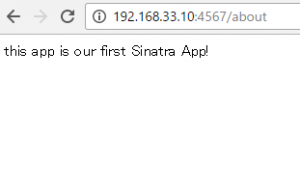require "sinatra" get "/" do puts "you requested the root path" end
Here we go!
require "sinatra"
get "/" do
"you requested the root path"
end
get "/about" do
"this app is our first Sinatra App!"
end
get "/roll-die" do
"Your die roll is...#{rand(1...7)}"
end

use variable in routing
require "sinatra" get "/r/SUBREDDIT_NAME/POST_ID/POST_TITLE" do "this is a post" end
getting a patter with post
require "sinatra"
get "/greet/:name" do
"Hello there #{params[:name]}!"
end
Think about capitalize
get "/greet/:name" do
name = params[:name].capitalize
"Hello there #{name}!"
end
try out this
get "/square/:num" do num = params[:num].to_i num * num end

